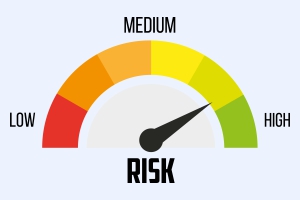It is scary to jump off a cliff or dive into the ocean, right? Risk is one of the most noticeable things people see in a new experience. So, if you are scared to invest in mutual funds because of the risk involved, you are certainly not alone. But it is also important to know about a high-risk mutual fund because it has the potential to offer high returns over time. Let’s know more about this.
Understanding risk in mutual funds
“Mutual fund investments are subject to market risks” – you must have heard this a lot of times. Yes, every mutual fund investment is subject to market risks. However, the level of risk can differ according to the category and objective of the fund, investing style, market capitalisation, and other similar factors.
Since mutual funds are market-linked, they are susceptible to fluctuations and volatility. However, the risk is not necessarily something to be feared. Several strategies like long-term investing, selecting a fund with an experienced fund manager, investing through Systematic Investment Plans (SIPs), etc., can mitigate risk and contribute to better returns.
Risk varies in mutual funds from high to low and is directly related to returns in most cases. On that note, let’s get on to knowing a high-risk mutual fund.
High-risk mutual funds features
- Risk: As the name suggests, these funds carry high mutual fund risks.
- Asset allocation: High-risk mutual funds typically invest in stocks.
- Risk and reward ratio: Since the return potential is directly proportional to risk, a high-risk mutual fund can deliver comparatively better returns.
We have discussed risks enough. Now let’s look at the plus points of a high-risk mutual fund.
Advantages of high-risk mutual funds
- Capital appreciation: High-risk mutual funds can help with capital appreciation. They can deliver optimal returns when you invest in them for the long term.
- Inflation-beating returns: A high-risk mutual fund may help with countering inflation risk. The fund can deliver a higher rate of return than the average inflation rate.
- Tax benefits: Some high-risk funds, like the Equity Linked Saving Scheme (ELSS), can offer tax benefits under Section 80C of the Income Tax Act, 1961. You can claim a tax deduction of up to Rs. 1.5 lakh per annum and save up to Rs. 46,800 in taxes each year.
- Multiple investment modes: You can use different investment methods to invest in high-risk mutual funds, such as in a lump sum or through an SIP. The latter can help lower the risk as your investment gets broken down into smaller investments spread over the long term. SIPs also offer other benefits, such as rupee cost averaging that averages out your investment cost, less financial burden and stress, and the power of compounding that reinvests your profits into the market to earn more. You can use an SIP calculator to plan your investments in high-risk mutual funds through SIPs.
Should you invest in high-risk mutual funds?
These funds can carry high risk, so they may be ideal if you have a high-risk appetite. They may not be suitable if you are new to investing, are retired, or have a low-risk appetite.
Conclusion
High-risk mutual funds are not to be feared. They only require a different financial planning approach. Keeping a long-term view and understanding the objectives and risks involved can help.
An investor education initiative by Edelweiss Mutual Fund
All Mutual Fund Investors have to go through a one-time KYC process. Investors should deal only with Registered Mutual Fund (RMF). For more info on KYC, RMF and procedure to lodge/redress any complaints, visit - https://www.edelweissmf.com/kyc-norms
MUTUAL FUND INVESTMENTS ARE SUBJECT TO MARKET RISKS. READ ALL SCHEME-RELATED DOCUMENTS CAREFULLY
Trending Articles
MUTUAL FUND INVESTMENTS ARE SUBJECT TO MARKET RISKS, READ ALL SCHEME RELATED DOCUMENTS CAREFULLY.




















